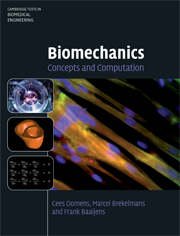Book contents
- Frontmatter
- Contents
- About the cover
- Preface
- 1 Vector calculus
- 2 The concepts of force and moment
- 3 Static equilibrium
- 4 The mechanical behaviour of fibres
- 5 Fibres: time-dependent behaviour
- 6 Analysis of a one-dimensional continuous elastic medium
- 7 Biological materials and continuum mechanics
- 8 Stress in three-dimensional continuous media
- 9 Motion: the time as an extra dimension
- 10 Deformation and rotation, deformation rate and spin
- 11 Local balance of mass, momentum and energy
- 12 Constitutive modelling of solids and fluids
- 13 Solution strategies for solid and fluid mechanics problems
- 14 Solution of the one-dimensional diffusion equation by means of the Finite Element Method
- 15 Solution of the one-dimensional convection-diffusion equation by means of the Finite Element Method
- 16 Solution of the three-dimensional convection-diffusion equation by means of the Finite Element Method
- 17 Shape functions and numerical integration
- 18 Infinitesimal strain elasticity problems
- References
- Index
6 - Analysis of a one-dimensional continuous elastic medium
Published online by Cambridge University Press: 05 June 2012
- Frontmatter
- Contents
- About the cover
- Preface
- 1 Vector calculus
- 2 The concepts of force and moment
- 3 Static equilibrium
- 4 The mechanical behaviour of fibres
- 5 Fibres: time-dependent behaviour
- 6 Analysis of a one-dimensional continuous elastic medium
- 7 Biological materials and continuum mechanics
- 8 Stress in three-dimensional continuous media
- 9 Motion: the time as an extra dimension
- 10 Deformation and rotation, deformation rate and spin
- 11 Local balance of mass, momentum and energy
- 12 Constitutive modelling of solids and fluids
- 13 Solution strategies for solid and fluid mechanics problems
- 14 Solution of the one-dimensional diffusion equation by means of the Finite Element Method
- 15 Solution of the one-dimensional convection-diffusion equation by means of the Finite Element Method
- 16 Solution of the three-dimensional convection-diffusion equation by means of the Finite Element Method
- 17 Shape functions and numerical integration
- 18 Infinitesimal strain elasticity problems
- References
- Index
Summary
Introduction
In the previous chapters the global behaviour of fibres was considered, without much attention to the detailed shape of these structures. Only the length change of the fibre played a role in the analysis. In the present chapter we address in a little bit more detail the deformation of long slender structures. These can be tendons, muscles, but also long bones. The aim is, to generalize the concepts introduced in previous chapters for discrete systems (i.e. springs) to continuous systems. To simplify matters the loading and deformation of a one-dimensional elastic bar is considered.
Equilibrium in a subsection of a slender structure
Consider a straight bar as visualized in Fig. 6.1(a), loaded by an external force F at x = L and fixed in space at x = 0. The figure shows the bar with the x-axis in the longitudinal or axial direction. It is assumed, that each cross section initially perpendicular to the axis of the bar remains perpendicular to the axis after loading. In fact it is assumed that all properties and displacements are a function of the x-coordinate only.
The objective is, to compute the displacement of each cross section of the bar due to the loading. The area of the cross section perpendicular to the central axis of the bar as well as the mechanical properties of the bar may be a function of the x-coordinate. Therefore the displacement may be a non-linear function of the axial coordinate.
- Type
- Chapter
- Information
- BiomechanicsConcepts and Computation, pp. 99 - 113Publisher: Cambridge University PressPrint publication year: 2009



